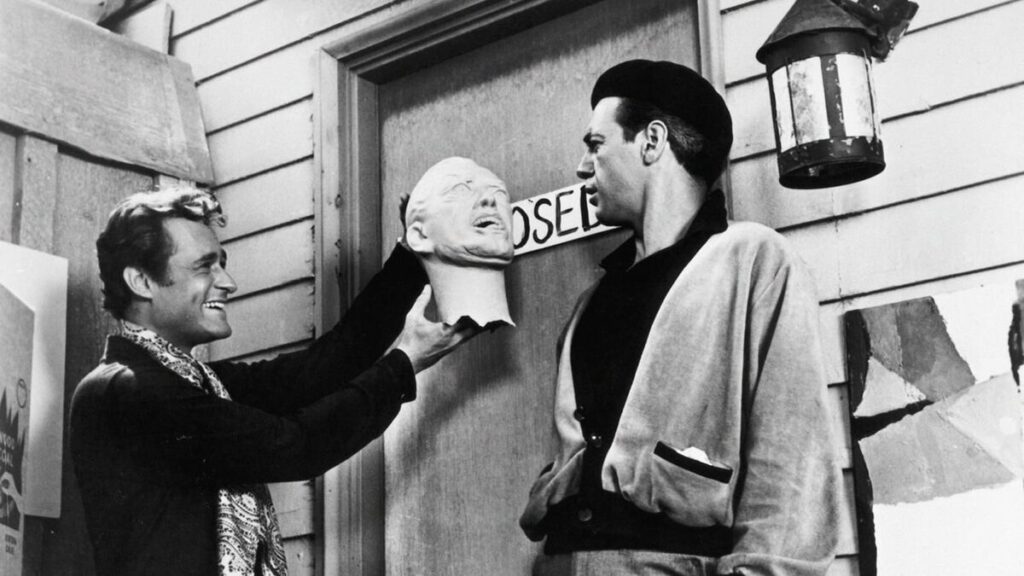
Dick Miller plays Walter Paisley; a bus boy, a square, a doofus and a homicidal maniac. After years of working at the trendy Beatnik cafe The Yellow Door Walter accidentally discovers a knack for sculpture when he inadvertently kills his landlady’s (Myrtle Vail) cat. He covers the corpse in clay and convinces Leonard (Antony Carbone), an art dealer and manager of The Yellow Door, to sell the work. Encouraged by poet Maxwell H. Brock (Julian Burton) and the crush of his life Carla (Barboura Morris), Walter embarks on a spree of murders in order to make his sculptures and become the toast of the Bohemian scene.
A Bucket Of Blood (1959) is the first of three satirical horror films made at American International Pictures by director/producer Roger Corman and screenwriter Charles B. Griffith. Many of the sets and plot points of A Bucket Of Blood were retooled or redressed for the more famous follow-up The Little Shop Of Horrors (1960). None of the other films that Corman and Griffith made together proved as sharp witted as A Bucket Of Blood which remains the favorite amongst film aficionados.
The most singular element that sets A Bucket Of Blood apart from other AIP horror-comedies of the time is Griffith’s scathing portrayal of Beatnik culture. Social commentary of this sort wasn’t the norm for a Roger Corman production, let alone commentary that was so pointed in its criticisms. The character Maxwell Brock presides over the Beatnik scene in A Bucket Of Blood as an obvious lampooning of Kenneth Rexroth. The character epitomizes the socially toxic world of the Beatniks from the rampant peer pressuring to the blatant misogyny. Brock is a grotesque caricature whose value system permits Walter’s unique brand of carnage.
The nature of Walter’s crimes and of his resulting art is a literal reading of Joseph Schumpeter’s concept of “schöpferische Zerstörung” or “creative destruction”. Not only does Walter destroy to create and thereby externalizing an inversion of the creative process, but he is also making money that he will never see nor live to enjoy. Walter’s crimes create a moral and economic circuit that trap the character within a capitalist complex from which the only escape is death. When read this way, A Bucket Of Blood becomes a parody of the post-war economic boom and an indictment of society’s commodification of art as status symbol.
All of this would be meaningless if not for Dick Miller’s performance as Walter Paisley. Miller imbues the hapless Walter with a naive earnestness that makes the character empathetic right up to his bitter end. Unlike Seymour in The Little Shop Of Horrors, Walter exists with more human depth and specificity, thereby giving A Bucket Of Blood a greater emotional stake for the audience. As campy and macabre as Corman’s style is in A Bucket Of Blood it never hampers nor detracts from Miller’s performance.
The primary reason that A Bucket Of Blood is lesser known than The Little Shop Of Horrors is that the nature of the murders in A Bucket Of Blood are wholly internalized. Walter isn’t pressured into killing people by some sentient, blood thirsty plant from outer space, he turns to murder out of a twisted sense of self-gratification and a need for public recognition. Walter’s murders aren’t quick, disposable narrative gestures either. Walter coats his victims in clay and the cadavers linger on as art that remains ever present in the film as a reminder of not just Walter’s crimes but also of society’s complicity in allowing these crimes to occur. A Bucket Of Blood, despite all of its superficial silliness, is a dark and sinister little film.
